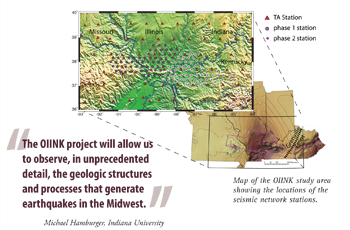What is OIINK?
Three university research teams from Indiana University, Purdue University, and the University of Illinois—together with the Indiana and Illinois state geological surveys—have teamed up to take on an ambitious project to help understand earthquakes and the geological structures that trigger them.
This new research project, supported by the National Science Foundation, is playfully dubbed “OIINK” after its principal study area—the Ozarks, Illinois, Indiana, and Kentucky.
The project involves the operation of a large seismic array centered over the Illinois Basin. This new project is being conducted in coordination with the deployment of a nationwide array of seismometers called the USArray (www.iris.edu/USArray/).
USArray is a component of a large experimental program called EarthScope (www.earthscope.org), a national scientific experiment directed at understanding the geologic processes that create earthquakes and their relation to continental-scale geologic structures.
A Telescope to Peer into Earth’s Interior
The OIINK experiment is directed at improving our understanding of the structure of North America’s continental interior. Our study area includes some of the world’s best examples of geologic structures typical of Earth’s continental interiors (or “cratons”).
Our seismic network, which will eventually include 120 earthquake monitoring stations, will span four of the major geologic structures that characterize the midcontinental area of the central U.S.: the Ozark Dome of southeastern Missouri, the Illinois Basin Grenville of southern Illinois and Indiana, the Rough Creek Graben of western Kentucky, and the Grenville Front of central Kentucky. These features also include major fault zones such as the Wabash Valley seismic zone, the source of many earthquakes in the Midwest.
The study is intended to help us understand the structure of the Earth’s crust and underlying mantle, the causes of earthquakes within the interior of an otherwise stable craton, and the geologic history of the North American continent.

